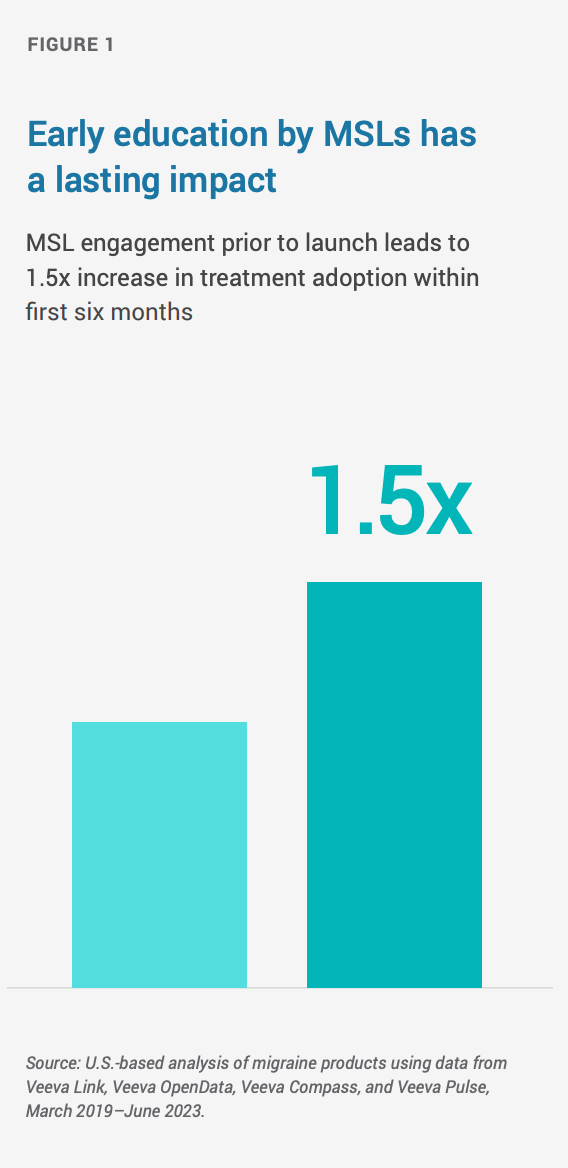
Traditional KOL planning often misses the most relevant scientific and medical experts. Leading companies are using data in new ways to identify, access, and engage KOLs for greater impact.
Field medical engagement with key opinion leaders (KOLs) before a
product launch correlates to a measurable increase in treatment adoption,
according to the latest Veeva Pulse Field Trends report [Figure 1].
However, traditional KOL plans over-index
on individuals that medical science liaisons
(MSLs) already know and can access, failing
to prioritize those that could be more relevant.
Fragmented KOL data and a lack of visibility
into emerging experts act as barriers to finding
and accessing the right people. As a result,
30% of global experts1
have no recorded
interactions with MSLs, limiting scientific
exchange, medical insights, and potential
treatment adoption.
In this white paper, you’ll learn how to increase
the effectiveness of your MSL team by
rethinking KOL identification, prioritization,
and engagement.
Leading companies are using deep KOL data
and a proven expert ranking methodology to:
- Find new customers and improve their
chances of engaging with them successfully - Develop closer relationships with experts
who are already relevant to their
organizations - Improve the impact and strategic value
of their MSL teams

Pushing on open doors
Plans to identify KOLs often default to manual
research of publicly available information centered
on limited criteria: think internet searches relating
to which experts have recently published or spoken
at congresses. However meticulous, this approach
quickly reaches its limitations in a dynamic landscape
that includes digital opinion leaders (DOLs) and
emerging experts [Figure 2].
While such public information is illustrative, it might
not succeed in pinpointing the most relevant experts
for your engagement objectives. For example, teams
could easily overlook digital leaders — HCPs who
might not have published much recent research but
still have a strong online presence and are influential
in the scientific and medical community.
As Robert Faison, executive director of medical affairs
at Paratek, observes: “There’s also a key opinion leader
that’s in the community. These are more than likely
the people who are actually treating the majority of
patients.” They should not be overlooked.
A typical outcome of traditional planning is an
overreliance on KOLs who already have well-established
relationships with an organization. To be more
effective, your medical teams need to ensure that data
informs your field medical strategy when identifying,
segmenting, and collaborating with experts.
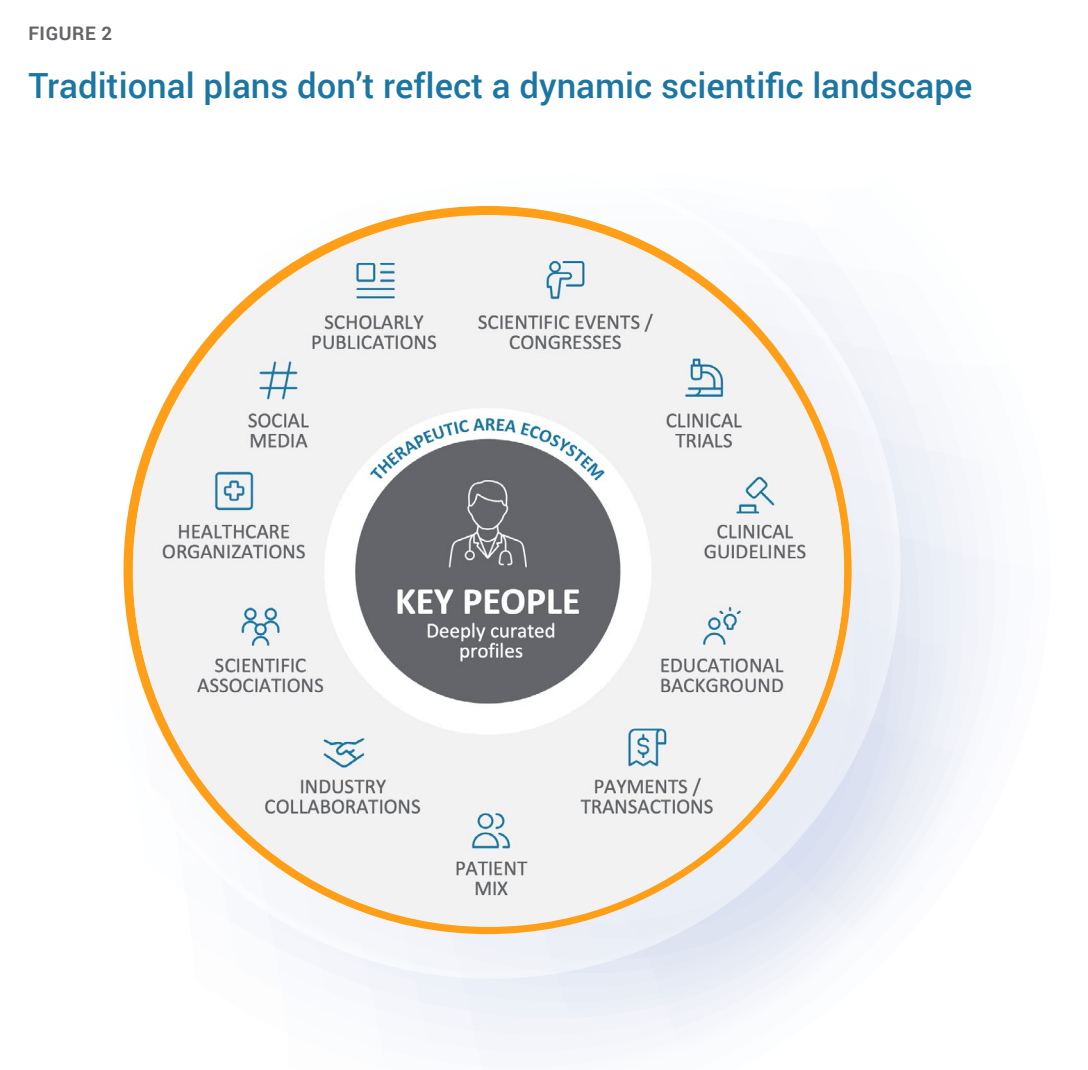
“We’re really taking a data-driven approach to our engagement with
external experts to ensure our science is communicated in a way that’s
meaningful and helps positively impact patient outcomes.”
– Tom Keith-Welsh, Head of Medical Digital, Data, Analytics, and Systems,GSK
Introducing common standards across the organization and taking a more
systematic approach to research will increase the chance of finding the right
KOLs for your treatment. Using one comprehensive source of information
will improve how MSLs engage those experts and, later, form productive
partnerships [Figure 3].
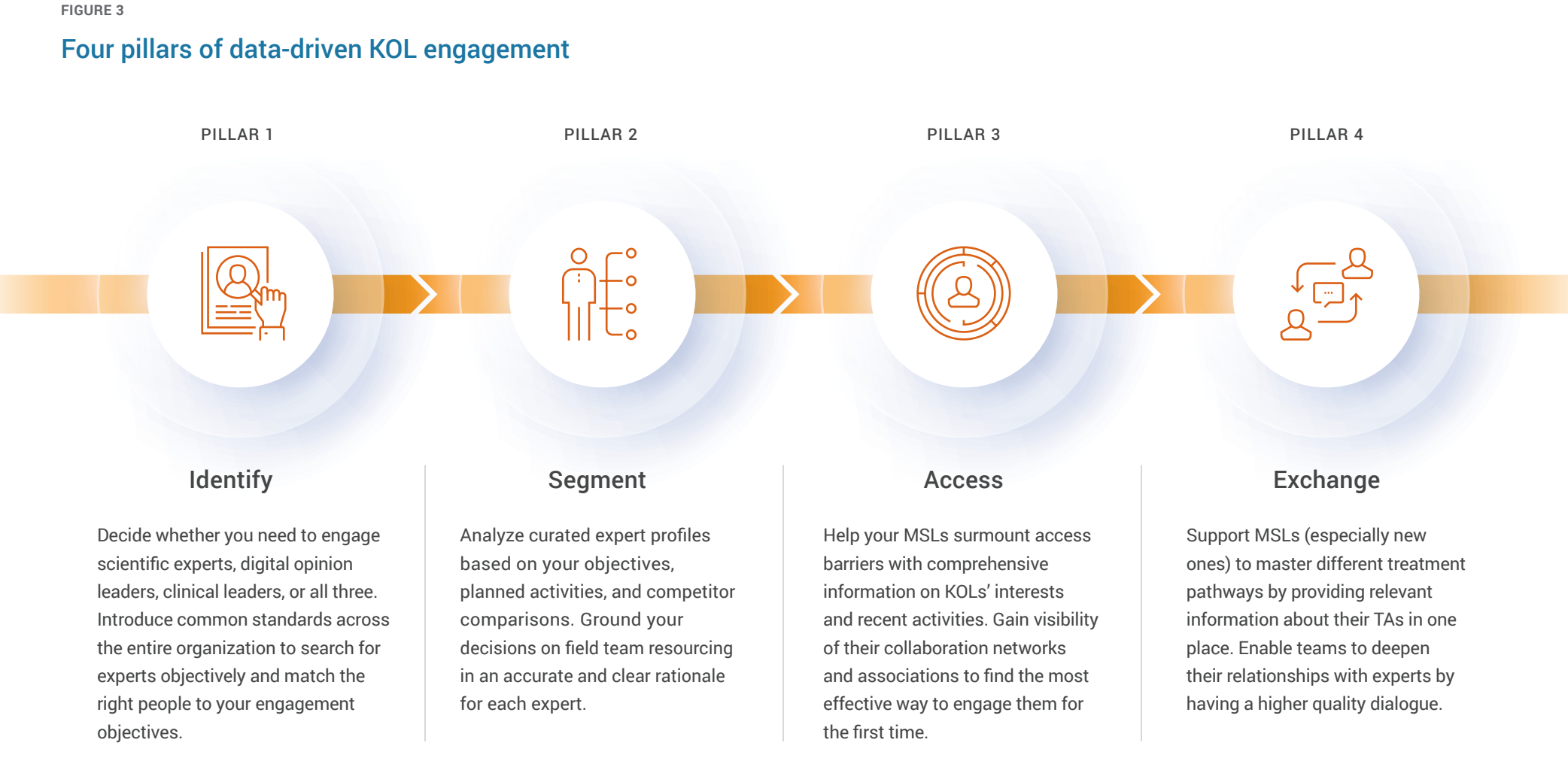
PILLAR 1
Identify the most relevant experts
Your medical affairs teams will need to engage
different experts based on the product lifecycle
stage and specific activity. Their audiences will
look distinct depending on whether the company
is in the pre-launch phase (when early advocacy
and product awareness are the focus) or asset
planning (when trial and eventual adoption
are the goals).
Once medical teams identify which audiences
they need to engage, they must accurately
match KOLs to each use case. Done manually this
is like searching for the needle in the proverbial
haystack, as teams are forced to sift through a
deep pool of potential physicians and consider
all relevant experience against multiple vectors
[Figure 4].
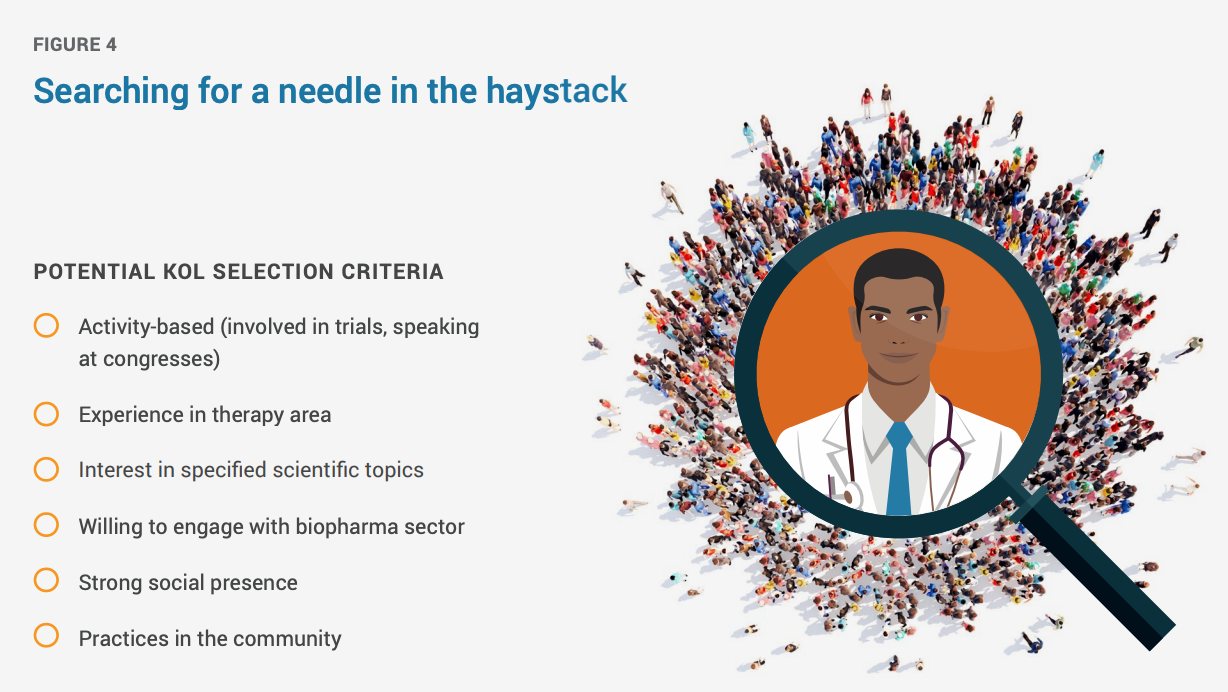
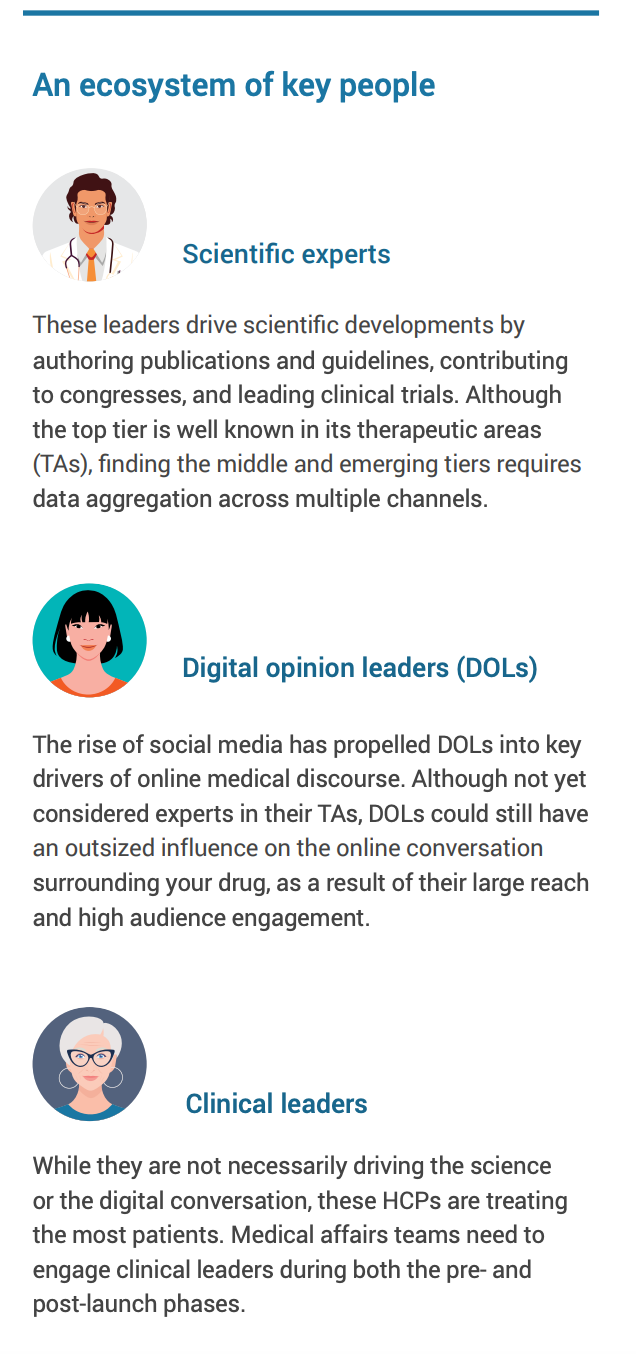
Taking a data-driven approach increases the
chance of shortlisting only the most relevant
KOLs. An effective KOL data platform will
extract, organize, and store live data from a
vast number of sources so your teams can
hone in on the right audience for each use case.
Teams can then analyze and shortlist each KOL
objectively, helping to avoid an overreliance on
well-established relationships. When integrated
with your CRM, this intelligence can be viewed
alongside related data, such as all the KOL’s
previous interactions with your organization.
Applying common standards across the
company should also remove bias and save
time. For instance, if the whole organization uses
the same scoring approach and can filter and
visualize searches, it becomes straightforward
to decile KOLs across multiple vectors. Scale
becomes achievable with these capabilities.
“It’s straightforward to find the top layer of
experts, as they publish a lot. Veeva Link
helped us to identify the middle group that is
important enough to matter but not yet wellknown. This is critical for a launch and when
you’re moving into a new therapeutic area.”
– Bas Van de Kamp, Director, Medical Affairs Systems, Idorsia Pharmaceuticals
HOW CAN A DATA-DRIVEN APPROACH HELP?
- Data is collected and curated from myriad
sources so it is easier to find the right experts
for specific activities - Objective scoring approach eliminates bias
- One source of truth means common standards
can be set - Identify rising stars and be confident that
the full range of experts is accounted for
IMPACT FOR YOUR ORGANIZATION
- Avoid hours of incomplete/inconsistent manual research
- End over-reliance on established KOL relationships
“Veeva Link Key People is a very useful tool.
It provides a way not only to identify [KOLs]
but also validate their level. It can actually
give you a score associated with their
prominence in research and presentations
at major meetings and symposia, and their
social media presence.”
– Robert Faison, Executive Director, Medical Affairs, Paratek
PILLAR 2
Segment potential experts
Once you are confident that you have a complete
set of relevant experts, you can start to segment
the list, profile key people for your treatment,
and plan field team outreach. Industry data can
answer strategic planning questions, including:
- Which experts are most relevant for specific
activities e.g., clinical trials, publications,
speaking on an identified topic? - Which experts will help maximize our reach?
- What is the optimal number to approach for
a given objective, and how do we make better
use of the network effort? - Are there digital influencers we should
engage? - Which ones are ‘digital originators’ (who share
their own ideas) vs. ‘digital messengers’ (who
mostly amplify other people’s content)?
Teams benefit from using the same KOL data
platform and working from one set of information.
For instance, leading biopharma companies
like Astellas and GSK are in the process of
streamlining their approach to KOL engagement
globally: all teams use the same industry KOL
intelligence data, which provides curated expert profiles with objective scoring of their scientific
and digital activities.
Medical affairs finds it easier to complete their
analysis and make competitor comparisons (for
example, during fair-value assessments) when
working from a single source of truth.
Importantly, using trusted industry data doesn’t
rule out evaluating KOLs against bespoke
criteria important to your organization (such as
whether access is even likely).
HOW CAN A DATA-DRIVEN APPROACH HELP?
- Objective scores for segmentation and tiering
- Standardized, scalable approach across
the organization - Easier to analyze and make competitor
comparisons - Target lists can be regularly refreshed against
agreed criteria
IMPACT FOR YOUR ORGANIZATION
- Analysis feeds into resourcing models and decisions
- Make best use of field resources
- Match the right KOL to the right activity
- Clear rationale for each KOL saves time, improves accuracy, and transparency
“The right data is foundational to our
engagement strategy. We can quickly identify
who the relevant KOLs are, and organize
those KOLs based on when and where they
are sharing scientific information and what
scientific information they are sharing.”
– Christine Castro, Director, Medical Affairs Excellence, Lundbeck
PILLAR 3
Surmount access barriers
According to Veeva data, 30% of global experts
identified in Veeva Link Key People have no
recorded interactions with MSLs. Whether
medical affairs teams are overlooking these
KOLs in mapping exercises or simply failing
to record interactions, opportunities are being
missed — either to engage at all or to bring
insights back to the organization.
The right intelligence will help cut through to
experts that your organization cannot currently
access. By understanding KOL interests,
education backgrounds, patient mix, and recent
scientific activities, MSLs can prepare for calls
more effectively: this could range from minor
changes (e.g., a better icebreaker) to finding a
compelling reason why that expert should engage
with your company for the first time. Knowing
where a KOL stands on a topic important to them
will help MSLs improve their approach.
It’s easier to open doors once you understand
the connections between HCPs and how they’ve
collaborated previously. Knowing which peers
are in a KOL’s sphere of influence could help
bridge the gap to a previously inaccessible HCP.
You could gain visibility of a KOL’s environment
through the lens of related associations (for
instance, close connections to other members)
and congresses (e.g., if they are due to copresent or chair a speaker panel).
HOW CAN A DATA-DRIVEN APPROACH HELP?
- MSLs can see aggregated profiles of
each KOL’s interests and scientific activities
across channels - Network maps help teams find mutual
connections - Association maps identify opportunities
to make an introduction or arrange a meeting
IMPACT FOR YOUR ORGANIZATION
- Reach low-access KOLs by understanding their needs
- Use network maps to understand influence and connections
- Share a single customer view to improve cross-functional collaboration
“One of our field medics had been seeing a
particular thought leader for a long time and
thought they knew everything there was to
know about them. By looking at Veeva Link,
they found areas of unknown insight into
some of the thought leader’s activities. It took
that conversation onto a different level, built
their credibility, and it means that both have
a much more valuable conversation.”
– Worldwide Capability Lead, Customer Profiling and Insights, Top Ten Pharma
PILLAR 4
Deepen scientific exchange
MSLs are expected to master the different
treatment pathways (and associated risks)
in their disease area. They need to understand
the broader clinical picture, including the
competitive landscape, new clinical developments,
scientific discoveries, and emerging technology.
MSLs that bring a deep clinical understanding
and good knowledge of their customers’
interests and activities are best positioned
to facilitate genuine scientific exchange.
Deep data about a therapeutic area ecosystem
supports MSLs to build knowledge quickly —
critical during a launch — so they can translate
their expertise into effective messaging. This
is particularly important for new MSLs, who
usually face a steep learning curve.
MSLs will spend less time on manual research
if they can go to one place to access all
relevant information about their KOLs’ recent
activities and interests before trying to engage
them. It’s easier for these teams to reach out
proactively when the latest developments,
general medicine news, and education about
their TAs are at their fingertips.
HOW CAN A DATA-DRIVEN APPROACH HELP?
- MSLs gain knowledge quickly and
easily on their KOLs and TAs - New MSLs get up to speed quickly
- Accelerate MSL readiness during launch
- Track engagements (e.g., in CRM)
to measure impact
“Veeva Link is a very valuable resource.
Our MSLs were able to find all the information
at their fingertips and better prepare for
meetings with thought leaders and HCPs.”
– Jessica McDaniel, Senior Director, Head of US Field Medical Affairs, Genmab
IMPACT FOR YOUR ORGANIZATION
- MSLs spend less time on manual research and are more productive
- Stronger scientific exchange means closer expert relationships
- Real-time intelligence leads to more opportunities to engage
“The real-time insights from Veeva Link
enable fast reactions and more focused
and impactful engagements. They help
us build broader and deeper connections
with the scientific community.”
– Margaret Doyle, Senior Global Medical Affairs Leader, Teclistamab, Johnson & Johnson Innovative Medicine
Beginning a high-quality dialogue
Commercial success in biopharma hinges on
the effectiveness of medical affairs: these
teams play a critical role in identifying and
engaging the right experts at different stages
of the product lifecycle, taking into account
activities, channels, and potential impact.
Their interactions provide valuable market
feedback on a product’s potential in clinical
and commercial terms. When able to access
the right intelligence, field medical can extend
its reach by prioritizing KOLs based on
influence and engaging emerging experts.
Irrespective of whether or not you plan
to expand your MSL workforce, helping
medical affairs to work smarter and have
higher-quality interactions with the right
customers will maximize their impact.
“In the launch phase, you want to get the
data out to as many healthcare providers
as possible. Because of their sphere of
influence, KOLs allow you to do that.
By engaging the right KOL, you can actually
impact the knowledge of hundreds or
thousands of healthcare providers.”
– Robert Faison, Executive Director, Medical Affairs, Paratek
About us
Veeva is the global leader in cloud software for the life sciences industry. Committed to innovation,
product excellence, and customer success, Veeva serves more than 1,100 customers, ranging from
the world’s largest biopharma companies to emerging biotechs. As a Public Benefit Corporation,
Veeva is committed to balancing the interests of all stakeholders, including customers, employees,
shareholders, and the industries it serves.
For more information, visit www.veeva.com
Hear how Astellas is using deep KOL data to strengthen scientific relationships and launch in new therapeutic areas.
